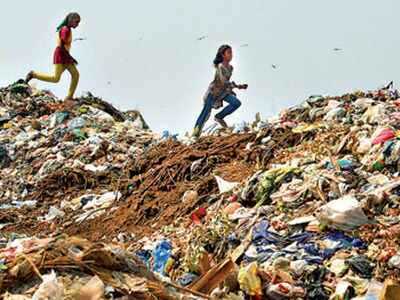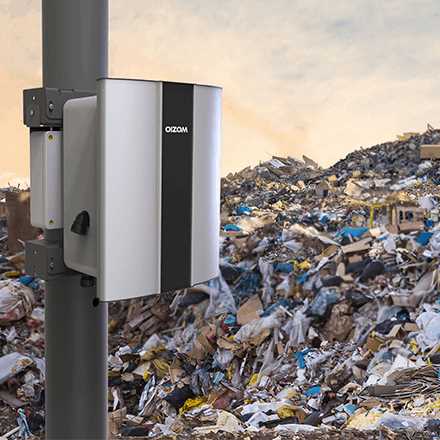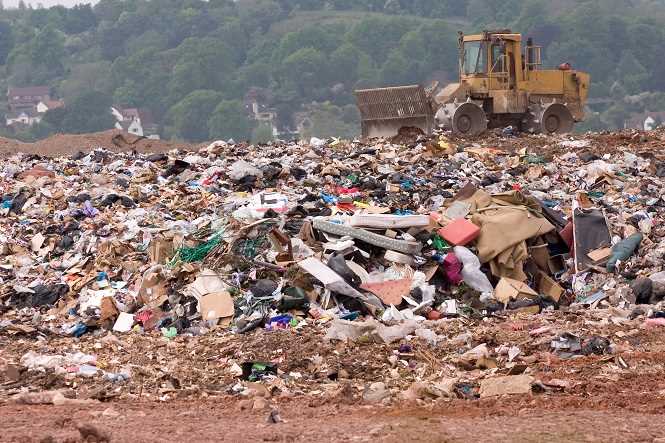
Landfills have long been associated with a pungent, foul smell that can be detected from miles away. This stench has earned landfills a reputation as one of the most unpleasant places to be around. But is the odor issue really as bad as it seems?
It’s true that landfills can emit strong odors, often described as a mix of rotting garbage, methane gas, and other decomposing organic matter. These smells are not only unpleasant but can also be harmful to human health. The exact composition of landfill odor depends on various factors, including the type of waste being disposed of and the methods used for waste management.
One of the main culprits behind landfill odor is methane gas, which is produced during the decomposition of organic waste. Methane is a greenhouse gas that contributes to climate change and has a distinct, rotten-egg odor. Landfills also produce other volatile organic compounds (VOCs), which can have a variety of odors, ranging from sweet and fruity to acrid and chemical-like.
However, it’s important to note that efforts have been made to mitigate the odor issue in landfills. Many modern landfills are equipped with systems that capture and treat landfill gas, reducing both the smell and the environmental impact. Additionally, waste management practices, such as covering the waste with soil or other materials, can help to minimize the release of odorous compounds.
While landfills may still have a reputation for being stinky, it’s clear that strides have been made to address the odor issue. By implementing better waste management practices and investing in odor control technologies, we can work towards a future where landfills are no longer synonymous with bad smells.
- Are Landfills Really Stinky?
- The Environmental Impact of Landfill Odor
- Air Pollution
- Health Risks
- Environmental Contamination
- Factors Contributing to Landfill Odor
- Health Risks Associated with Landfill Odor
- Potential Respiratory Issues
- Impact on Mental Health and Well-being
- Efforts to Control Landfill Odor
- Emerging Technologies in Landfill Odor Reduction
- Q&A
- Why do landfills have a bad smell?
- Can the odor from landfills be harmful to human health?
- What measures are taken to control the odor from landfills?
- Are there any alternatives to landfills that don’t produce a bad smell?
Are Landfills Really Stinky?
Landfills have long been associated with unpleasant odors, making them a topic of concern for nearby residents and environmental activists. But are landfills really as stinky as they are often perceived to be?
The answer is a bit more complex than a simple “yes” or “no.” While it is true that landfills can produce odors, the intensity and extent of these odors can vary depending on various factors such as the type of waste, weather conditions, and management practices.
When organic waste decomposes in a landfill, it releases gases such as methane and hydrogen sulfide, which can have strong, unpleasant smells. These compounds are often responsible for the characteristic “rotten egg” smell associated with landfills.
However, modern landfill management practices have significantly improved in recent years, aiming to mitigate odor issues. Advanced technologies, such as gas collection systems and engineered landfill liners, help capture and contain odorous gases, reducing the release of unpleasant smells into the surrounding environment.
Furthermore, regulations and guidelines now exist to ensure that landfill operators implement proper odor control measures. This includes measures such as installing odor control systems, covering waste with daily soil cover, and regular monitoring to address any odor complaints promptly.
It is worth noting that not all landfills are created equal when it comes to odor. Some modern landfills have implemented innovative techniques, such as bioreactors, which accelerate waste decomposition and reduce odor emissions. Additionally, landfills that accept primarily non-organic and inert waste are less likely to produce strong odors.
In conclusion, while landfills can indeed be associated with unpleasant smells, the stinkiness of a landfill depends on several factors, including the type of waste, management practices, and the implementation of odor control measures. With advancements in technology and regulation, efforts are being made to minimize odor issues and make landfills more environmentally friendly and socially acceptable.
The Environmental Impact of Landfill Odor
While the stench emitted from landfills can be a major nuisance for nearby residents, the environmental impact of landfill odor extends beyond its unpleasant smell. The release of foul odors into the air can contribute to air pollution and have harmful effects on both human health and the environment.
Air Pollution
The decomposition of organic waste in landfills produces a variety of gases, including methane, hydrogen sulfide, and volatile organic compounds (VOCs). These gases are responsible for the foul smell associated with landfills. When released into the air, they can contribute to air pollution.
Methane, a potent greenhouse gas, is a primary concern. Landfills are one of the largest sources of methane emissions globally. Methane is known to have a significant impact on climate change, as it has a much higher warming potential than carbon dioxide. The release of methane from landfills contributes to the greenhouse effect, trapping heat in the atmosphere and exacerbating global warming.
Health Risks
In addition to contributing to air pollution and climate change, landfill odor can pose direct health risks to nearby communities. Hydrogen sulfide, one of the gases released from rotting waste, can cause respiratory problems, eye irritation, and even neurological effects when inhaled in high concentrations.
Furthermore, the presence of landfill odor can negatively impact the quality of life for residents living nearby. The persistent and unpleasant smell can cause stress, discomfort, and even psychological distress in individuals exposed to it on a regular basis.
Environmental Contamination

Landfill odor can also contribute to environmental contamination. Volatile organic compounds (VOCs) released from decomposing waste can react with sunlight and other pollutants to form ground-level ozone, a major component of smog. Ground-level ozone can harm plants, animals, and ecosystems and contribute to respiratory issues in humans.
| Environmental Impact | Description |
|---|---|
| Damage to Ecosystems | Landfill odor and its associated pollutants can harm local ecosystems, affecting wildlife, plants, and water sources. |
| Contamination of Soil and Water | The gases released from landfills can leach into the soil and contaminate groundwater, potentially affecting drinking water sources. |
In conclusion, the environmental impact of landfill odor goes beyond its unpleasant smell. It contributes to air pollution, climate change, and poses health risks to nearby communities. Additionally, it can contaminate soil and water, damaging ecosystems and compromising water sources. Efforts to minimize landfill odor are crucial for mitigating these environmental impacts and ensuring a healthier and more sustainable environment.
Factors Contributing to Landfill Odor
Landfill odor is primarily caused by the decomposition of organic waste materials. When organic waste, such as food scraps or yard waste, is buried in a landfill, it begins to break down. During this decomposition process, gases are released, which contribute to the unpleasant odors commonly associated with landfills.
Several factors can contribute to the strength and persistence of landfill odors:
- The type and quantity of waste: Different types of waste, such as food or animal waste, can produce different odors. Additionally, the volume of waste in a landfill can influence the intensity of odors.
- The age of the landfill: Older landfills tend to have a higher concentration of decomposing waste, leading to stronger odors.
- The cover material used: Covering the waste with a layer of soil or other materials can help contain odors. However, if the cover material is not effective, odors may still be released.
- The weather conditions: Temperature, humidity, and wind patterns can affect how odors disperse and travel from the landfill. Hot and humid weather can increase the intensity of odors, while strong winds can carry the odor over longer distances.
- The landfill design and management practices: Factors such as the depth of the landfill, the presence of gas collection systems, and the use of odor control measures can impact the level of odor emissions from the landfill.
It is important for landfill operators to implement proper waste management practices and odor control strategies to minimize the impact of odor on surrounding communities. This may include using landfill gas collection systems, installing covers or barriers to contain odors, and regularly monitoring and maintaining the landfill to prevent excessive odor emissions.
Health Risks Associated with Landfill Odor
While landfill odor is often just considered a nuisance, it can pose potential health risks to nearby communities and workers. The strong, unpleasant smell is usually a combination of various gases, chemicals, and decomposing organic matter, which can release harmful pollutants into the air.
Potential Respiratory Issues
The gases emitted from landfills, such as methane and hydrogen sulfide, can irritate the respiratory system and cause breathing difficulties for individuals who are exposed to high levels of these gases. Prolonged exposure to landfill odor can exacerbate pre-existing respiratory conditions such as asthma and chronic obstructive pulmonary disease (COPD), leading to more frequent attacks and worsening symptoms.
Impact on Mental Health and Well-being
The constant exposure to unpleasant odor from landfills can also have a negative impact on mental health and overall well-being. The offensive smell can cause stress, anxiety, and even depression among individuals living or working in close proximity to landfills. This can have detrimental effects on their quality of life and daily activities.
Furthermore, studies have suggested a potential link between landfill odor and certain health conditions:
- Headaches: The chemicals and gases released from landfills can trigger headaches in individuals who are sensitive to such odors.
- Nausea and Vomiting: Prolonged exposure to landfill odor may induce feelings of nausea and even lead to vomiting in some cases.
- Eye and Throat Irritation: The volatile organic compounds (VOCs) released from landfills can cause irritation and discomfort in the eyes and throat.
It is important for local authorities and landfill operators to address the issue of odor emissions to minimize the potential health risks for nearby communities and workers. Implementing proper waste management practices, using effective odor control technologies, and regularly monitoring air quality can help mitigate the impact of landfill odor on human health.
Efforts to Control Landfill Odor

Landfills are known to produce unpleasant odors due to the decomposition of organic waste materials. These odors can be a nuisance for nearby communities and can impact the quality of life for residents.
To address this issue, landfill operators implement various strategies to control and minimize odor emissions. One common method is the use of landfill gas collection systems. These systems capture the gas produced during waste decomposition, which is composed primarily of methane and carbon dioxide. By collecting and treating this gas, landfill operators can significantly reduce the emission of odor-causing compounds into the air.
Another approach to controlling landfill odor is the use of daily or intermediate soil cover. This involves covering the waste with layers of soil or other materials to minimize contact with the air. By doing so, the release of odor-causing compounds is reduced, as the decomposition process occurs in a more oxygen-deprived environment.
In addition to gas collection systems and soil cover, landfill operators may also implement odor control technologies such as biofilters and chemical neutralizers. Biofilters use microorganisms to break down odor-causing compounds, while chemical neutralizers react with these compounds to minimize their smell. These technologies can be effective in reducing odor emissions from landfills.
Furthermore, proper waste management practices, such as segregating and compacting waste, can also help control landfill odor. By separating different types of waste and compacting them tightly, the surface area available for decomposition is reduced, thereby minimizing odor production.
Overall, efforts to control landfill odor involve a combination of gas collection systems, soil cover, odor control technologies, and proper waste management practices. These measures help mitigate the unpleasant smells associated with landfills, improving the quality of life for nearby residents and the surrounding environment.
Emerging Technologies in Landfill Odor Reduction
In recent years, there have been significant advancements in technologies aimed at reducing odor emissions from landfills. These emerging technologies are making significant strides in combating the stinky reputation of landfills and improving the overall air quality in surrounding areas.
One innovative technology is the use of biofilters. Biofilters are designed to capture and break down odorous gases emitted from landfill sites. They consist of a bed of organic material, such as compost or wood chips, through which the landfill gases pass. The organic material acts as a filter, trapping and degrading the odorous compounds. This process significantly reduces the odor impact on the surrounding environment.
Another promising technology is the installation of gas collection systems. These systems are designed to capture the landfill gas, which is a major contributor to odor emissions. The collected gas can then be treated and used as a source of renewable energy, reducing both odors and greenhouse gas emissions. This sustainable approach not only helps mitigate odor issues but also contributes to the overall environmental conservation efforts.
Furthermore, advancements in remote sensing technology are aiding in the detection and monitoring of odor emissions. These remote sensors are capable of identifying and measuring the concentration of odorous compounds in the air. This enables landfill operators to take prompt action and implement effective odor control measures. It also allows for real-time monitoring and adjustment, ensuring a proactive approach to odor reduction.
Finally, research is being conducted on the development of odor-reducing cover materials. These materials are applied to landfill surfaces and act as a barrier, preventing the escape of odorous compounds into the air. Some studies have shown that certain cover materials, such as bioactive clays, can effectively neutralize odors by adsorbing the compounds and preventing their release. This innovative approach has the potential to significantly reduce odor emissions in landfills.
Overall, these emerging technologies are revolutionizing the landfill industry by addressing the odor issue at its source. By implementing biofilters, gas collection systems, remote sensing technology, and odor-reducing cover materials, landfills can greatly minimize their impact on the environment and the surrounding communities. These advancements showcase the industry’s commitment to sustainable practices and the continuous improvement of air quality standards.
Q&A
Why do landfills have a bad smell?
Landfills have a bad smell because of the decomposition of organic waste. When waste is buried in a landfill, it undergoes anaerobic decomposition, which releases gases such as methane, ammonia, and hydrogen sulfide. These gases are responsible for the foul odor associated with landfills.
Can the odor from landfills be harmful to human health?
The odor from landfills can be unpleasant and irritating to some people, but it is generally not harmful to human health. The gases released from landfills can cause respiratory problems and headaches in some individuals, but these symptoms usually go away once the person is no longer exposed to the odor.
What measures are taken to control the odor from landfills?
There are several measures taken to control the odor from landfills. One common method is the use of landfill gas collection systems, which capture the gases released from the waste and divert them to be burned or used as a source of energy. Additionally, landfills are often lined with clay or synthetic liners to prevent the gases from escaping into the surrounding environment. Odor control systems, such as misting systems or odor neutralizers, may also be used to minimize the smell.
Are there any alternatives to landfills that don’t produce a bad smell?
Yes, there are several alternatives to landfills that can minimize or eliminate the bad smell associated with waste disposal. One alternative is waste-to-energy plants, where waste is burned to generate electricity. Another option is composting, which involves decomposing organic waste in a controlled environment to produce nutrient-rich compost. Recycling and waste reduction initiatives can also help to reduce the amount of waste that ends up in landfills and therefore decrease the smell.